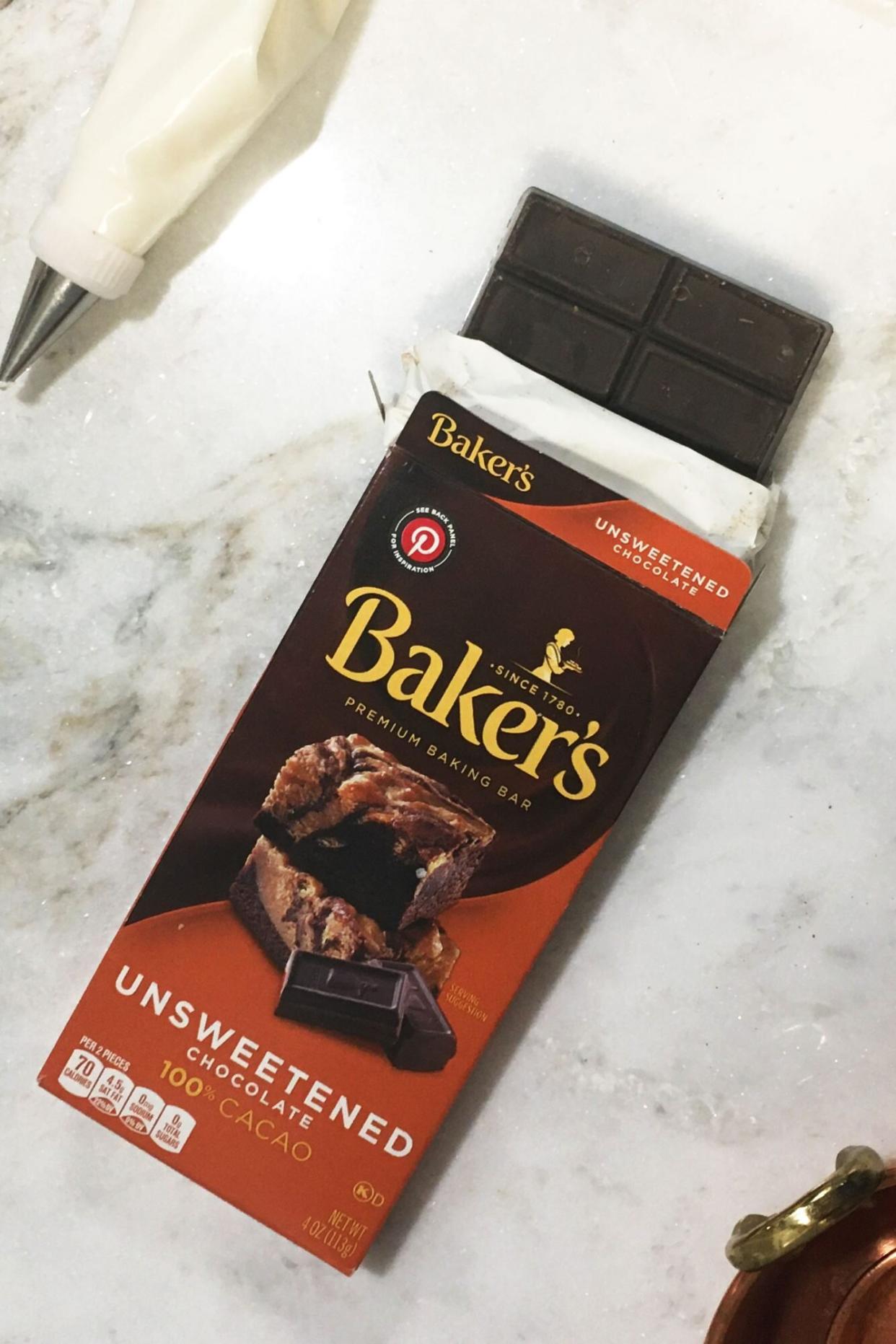What's the Difference Between Regular Chocolate and Baking Chocolate?

Southern Living
Wander down the baking aisle of any grocery store and you'll notice several boxes labeled baking chocolate. Some say unsweetened, others bittersweet or semi-sweet, another labeled German's sweet chocolate. Have you ever wondered what this chocolate is used for and how it's any different than the chocolate over in the candy aisle?
There's actually quite a big difference. For baking, it's important to understand the difference between regular chocolate and baking chocolate—plus, know how to select the right kind of chocolate for every recipe. We've broken it all down for you, from types of chocolate to how to use it.
What Is Baking Chocolate?
There are several kinds of baking chocolate, but in its purest form, baking chocolate is unsweetened chocolate. This means it's 100% chocolate (cacao) with no added sugar or flavor. It's sugar-free by design, as most recipes that call for unsweetened baking chocolate (also called bitter chocolate) are developed with the appropriate amount of sugar added to counteract its bitterness.
Unsweetened baking chocolate is not suited for all baking and should be used only when specified. For example, in a ganache recipe, which is just cream and chocolate, there isn't any added sugar, and so using unsweetened or classic baking chocolate would result in a ganache that's far too bitter. Unsweetened baking chocolate is great in recipes designed to have a rich chocolate flavor and contain enough sugar to balance it out, like in our So Good Brownies.
Types of Baking Chocolate
Pure baking chocolate may be unsweetened, but many other varieties of baking chocolate are also sold. These include:
Bittersweet Baking Chocolate
As the name hints, this chocolate has some sugar added to it. The Food and Drug Administration (FDA) requires both bittersweet and semi-sweet baking chocolate to contain at least 35% chocolate. Most bittersweet chocolate baking bars fall between 60% and 72% chocolate.
Unlike unsweetened or plain baking chocolate, bittersweet chocolate can contain flavors like vanilla, and emulsifiers like soy lecithin. Each brand that makes bittersweet chocolate baking bars will contain a different ratio of sugar to chocolate, so it's important to read the label and assess if it's the right kind of chocolate for the dessert you're making.
The more cacao or chocolate in the bar, the darker the chocolate flavor will be in your dessert. Bittersweet baking chocolate is great for striking a balance between sharp and sweet chocolate notes, like in our Chocolate Torte recipe.
Semi-sweet Baking Chocolate
Semi-sweet baking chocolate is sweeter than bittersweet, ranging from only 35% to 55% chocolate. You'll want to use this in desserts that don't need an intense chocolate flavor. Chunks of semi-sweet chocolate are perfect for chocolate chip cookies or scattered in banana bread.
Milk Chocolate Baking Chocolate
While you'll see baking bars labeled milk chocolate, they aren't really baking chocolate because of the addition of milk, as well as sugar and cocoa butter. Milk chocolate is the most mild baking chocolate in flavor and contain as little as 10% chocolate. It's commonly used in candy recipes and frostings.
German's Sweet Baking Chocolate
German's sweet baking chocolate is just that, sweeter baking chocolate— at least, sweeter than both semi-sweet and bittersweet chocolate.
According to MyRecipes, to substitute semi-sweet chocolate for German's sweet baking chocolate you would need to add an additional 1/2 tablespoon of sugar per ounce of chocolate.
This chocolate was invented by Samuel German who wanted to save bakers a step by combining the sugar with the chocolate. It's named German's sweet chocolate after him, not the country, and should only be used when specifically called for because of how much additional sugar it contains. It's of course perfect for German Chocolate Cake.
And What About Chocolate Chips?
While you bake with chocolate chips, they are not the same as baking chocolate. When a recipe calls for baking chocolate, it is specifically referring to bars of chocolate for baking, not chips. Chocolate chips have less cocoa butter and contain stabilizers to help keep their "chip" shape while baking. They usually can't be used interchangeably with baking chocolate in recipes. Although they might not make a big difference melted down into brownies, they can affect the texture and results of other desserts, especially when it comes to candy making.
Candy Aisle Chocolate Bars
Most candy bars have a ton of other ingredients beyond just sugar added to them. While you can find chocolate bars in the candy aisle with similar cacao percentages to baking chocolate, they are typically thinner, often flavored, and don't come in unsweetened varieties like baking chocolate does. Enjoy the chocolate in the candy aisle for snacks, stick closer to where the flour is stocked for chocolate to bake with.


